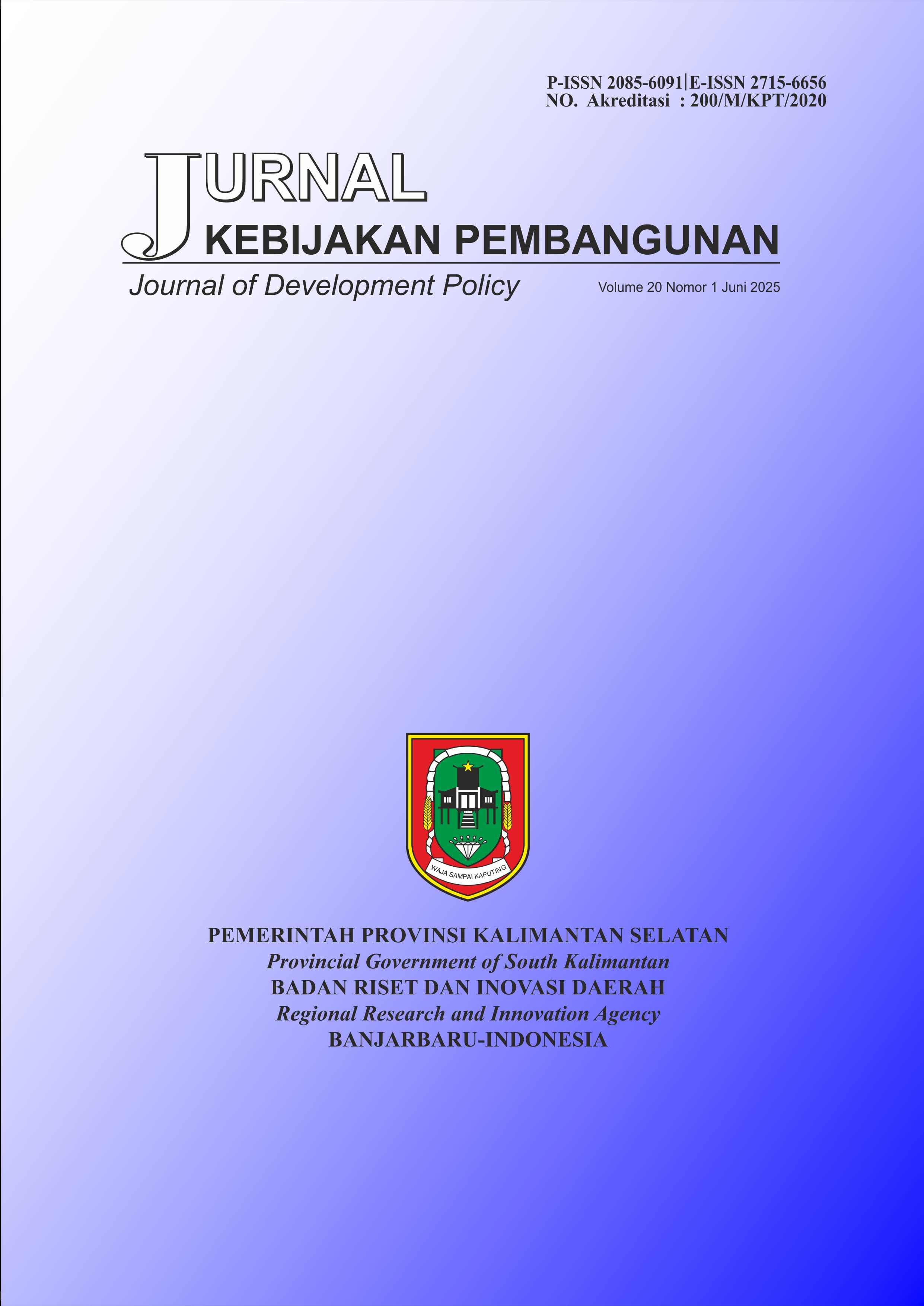Association Between Migration, Education, and Re-employment During the Covid-19 Pandemic in Kalimantan Selatan Province
DOI:
https://doi.org/10.47441/jkp.v20i1.398Keywords:
Formal Employment, Informal Employment, Internal Migration, Low-Education NativeAbstract
The Covid-19 pandemic has spread in Indonesia and caused an increase in unemployment, including in the Kalimantan Selatan Province. This research aims to analyze the relationship between migration, education, and the re-employment status of workers affected by layoffs in the early part of the Covid-19 pandemic using Sakernas August 2021 data. The analysis used was a multinomial logit model. The findings are that the labor force's migration and education status significantly impacted re-employment. High-education natives are more likely to be re-employed in formal employment than high-education migrants. On the other hand, low-education natives are more likely to be unemployed or less likely to be re-employed in formal employment than high-education migrants. In addition, low-education natives are more likely to be re-employed in informal employment than high-education migrants. These findings show that education is essential in increasing the chances of the native labor force getting better labor market outcomes.
Downloads
References
Amini, Ary Fauziah, Lilik Sugiharti, Neny Aditina, and Yefin Amandri Meidika. 2020. “Analisis Migran Risen di Sektor Formal dan Informal: Hasil Sakernas 2018.” Jurnal Ekonomi dan Bisnis 23 (1): 37–52. https://doi.org/10.24914/jeb.v23i1.2697.
Arifin, Evi Nurvidya, and Aris Ananta. 2023. “Employment of Highly-Skilled Migrants during the Pandemic: Focus on Internal Migration in Indonesia.” Asian and Pacific Migration Journal 32 (1): 60–82. https://doi.org/10.1177/01171968231169474.
Berker, Ali. 2011. “Labor-Market Consequences of Internal Migration in Turkey.” Economic Development and Cultural Change 60 (1): 197–239. https://doi.org/10.1086/661217.
Borjas, George J., Stephen G. Bronars, and Stephen J. Trejo. 1992. “Self-Selection and Internal Migration in the United States.” Journal of Urban Economics 32 (2): 159–85. https://doi.org/10.1016/0094-1190(92)90003-4.
Brodeur, Abel, David Gray, Anik Islam, and Suraiya Jabeen Bhuiyan. 2020. “A Literature Review of the Economics of Covid-19.” Discussion Paper Series IZA DP, no. 13411: 0–61.
Cahuc, Pierre, and Andre Zylberberg. 2004. Labor Economics. The MIT Press, Cambridge, MA.
Cairo, Isabel, and Tomaz Cajner. 2016. “Human Capital and Unemployment Dynamics: Why More Educated Workers Enjoy Greater Employment Stability.” The Economic Journal 128: 652–82. https://doi.org/10.1111/ecoj.12441.
Card, David, and Giovanni Peri. 2016. “Immigration Economics by George J . Borjas: A Review Essay.” Journal of Economic Literature 54 (4): 1333–49.
Carnevale, Anthony P., Tamara Jayasundera, and Artem Gulish. 2016. “America’s Divided Recovery: College Haves and Have-Nots.” Georgetown University, 44. https://eric.ed.gov/?id=ED574377%0A.
Corbi, Raphael, Tiago Ferraz, and Renata Narita. 2022. “Internal Migration and Labor Market Adjustments in the Presence of Nonwage Compensation.” In Annals of 44th Meeting of the Brazilian Econometric Society.
Dartanto, Teguh, Hera Susanti, Eldest Augustin, and Kania Fitriani. 2023. “Reemployment during the Covid-19 Pandemic in Indonesia: What Kinds of Skill Sets Are Needed?” Cogent Economics and Finance 11 (2). https://doi.org/10.1080/23322039.2023.2210382.
Glitz, Albrecht. 2012. “The Labor Market Impact of Immigration: A Quasi-Experiment Exploiting Immigrant Location Rules in Germany.” Journal of Labor Economics 30 (1): 175–213. https://doi.org/10.1086/662143.
Hanushek, Eric A., and Ludger Woessmann. 2008. “The Role of Cognitive Skills in Economic Development.” Journal of Economic Literature 46 (3): 607–68. https://doi.org/10.1257/jel.46.3.607.
Hohberg, Maike, and Jann Lay. 2015. “The Impact of Minimum Wages on Informal and Formal Labor Market Outcomes: Evidence from Indonesia.” IZA Journal of Labor and Development 4 (14). https://doi.org/10.1186/s40175-015-0036-4.
Hosmer, David W., and Stanley Lemeshow. n.d. “Applied Logistic Regression SEcond Edition.”
ILO. 2021. “Pemantauan ILO: Covid-19 dan Dunia Kerja. Edisi Ke-Tujuh.” https://www.ilo.org/wcmsp5/groups/public/---asia/---ro-bangkok/---ilo-jakarta/documents/publication/wcms_770140.pdf.
Lehmann, Hartmut, and Norberto Pignatti. 2018. “Informal Employment Relationships and the Labor Market: Is There Segmentation in Ukraine?” Journal of Comparative Economics 46 (3): 838–57. https://doi.org/10.1016/j.jce.2018.07.011.
Lemieux, Thomas, Kevin Milligan, Tammy Schirle, and Mikal Skuterud. 2020. “Initial Impacts of the Covid-19 Pandemic.” Canadian Public Policy, no. Juli: S55–65. https://doi.org/10.3138/cpp.2020-049.
Majid, Nomaan. 2012. “How Not to Count the Employed in Developing Countries.” Employment Working Paper 136, no. 136.
Manning, Chris, and Devanto S Pratomo. 2013. “Do Migrants Get Stuck in the Informal Sector ? Findings from a Household Survey in Four Indonesian Cities.” Bulletin of Indonesian Economic Studies 49 (2): 167–92. https://doi.org/10.1080/00074918.2013.772940.
McArthur, David Philip, Inge Thorsen, and Jan Ubøe. 2010. “A Micro-Simulation Approach to Modelling Spatial Unemployment Disparities.” Growth and Change 41 (3): 374–402. https://doi.org/10.1111/j.1468-2257.2010.00530.x.
Niebuhr, Annekatrin, Nadia Granato, Anette Haas, and Silke Hamann. 2012. “Does Labour Mobility Reduce Disparities between Regional Labour Markets in Germany?” Regional Studies 46 (7): 841–58. https://doi.org/10.1080/00343404.2010.532118.
Pardede, Elda L., and Rachmanina Listya. 2013. “Do They Look for Informal Jobs? Migration of the Working Age in Indonesia.” IUSSP International Population Conference III (8): 26–31. http://econ.feb.ui.ac.id/wp-content/uploads/2015/10/201308.pdf.
Prastiwi, Lustina Fajar. 2013. “Analisis Pekerja Migran Dan Nonmigran Perkotaan Pada Sektor Formal Dan Sektor Informal Di Indonesia.” Jurnal Ilmiah Mahasiswa FEB, Universitas Brawijaya 4 (1): 1–22.
Prates, Ian, and Rogério J Barbosa. 2020. “The Impact of Covid ‑ 19 in Brazil : Labour Market and Social.” The Indian Journal of Labour Economics. https://doi.org/10.1007/s41027-020-00252-3.
Strobl, Eric, and Marie Anne Valfort. 2015. “The Effect of Weather-Induced Internal Migration on Local Labor Markets. Evidence from Uganda.” World Bank Economic Review 29 (2): 385–412. https://doi.org/10.1093/wber/lht029.
Tadjoeddin, Mohammad Zulfan. 2015. “Spatial Dimensions of Key Employment Outcomes in Indonesia.” Journal of Comparative Asian Development 14 (3): 466–509. https://doi.org/10.1080/15339114.2015.1096552.
Tridiana, Clara, and Diah Widyawati. 2018. “Dampak Upah Minimum Terhadap Probabilitas Keluar dari Sektor Formal Minimum Wage.” Jurnal Ekonomi Dan Pembangunan Indonesia 18 (3): Article 8. https://doi.org/10.21002/jepi.2018.19.
Vidyattama, Yogi. 2014. “Inter-Provincial Migration and 1975-2005 Regional Growth in Indonesia.” Papers in Regional Science 95 (1): S87–105. https://doi.org/10.1111/pirs.12120.
Voogt, Joke, and Natalie Pareja Roblin. 2012. “A Comparative Analysis of International Frameworks for 21 St Century Competences: Implications for National Curriculum Policies.” Journal of Curriculum Studies 44 (3): 299–321. https://doi.org/10.1080/00220272.2012.668938.
Downloads
Published
How to Cite
Issue
Section
License
Authors who publish with this journal agree to the following terms:
- Authors retain copyright and grant the journal right of first publication with the work simultaneously licensed under a Creative Commons Attribution-NonCommercial-ShareAlike 4.0 International License that allows others to share the work with an acknowledgment of the work's authorship and initial publication in this journal.
- The journal allow the authors to hold the copyright without restrictions and allow the authors to retain publishing rights without restrictions.
- Authors can enter into separate, additional contractual arrangements for the non-exclusive distribution of the journal's published version of the work (e.g., post it to an institutional repository or publish it in a book), with an acknowledgment of its initial publication in this journal.
- Authors are permitted and encouraged to post their work online (e.g., in institutional repositories or on their website) before and during the submission process, as it can lead to productive exchanges, as well as earlier and greater citation of published work.















 This work is licensed under a
This work is licensed under a 